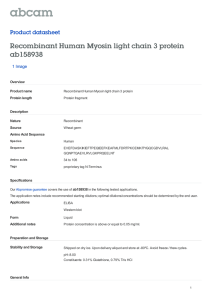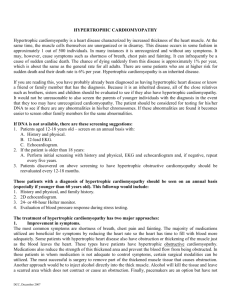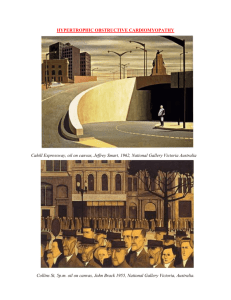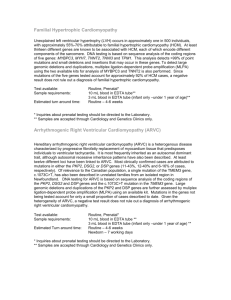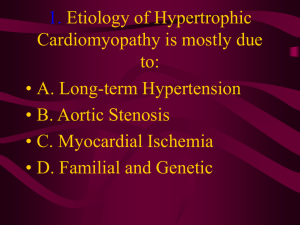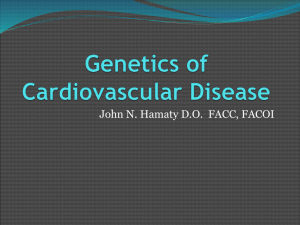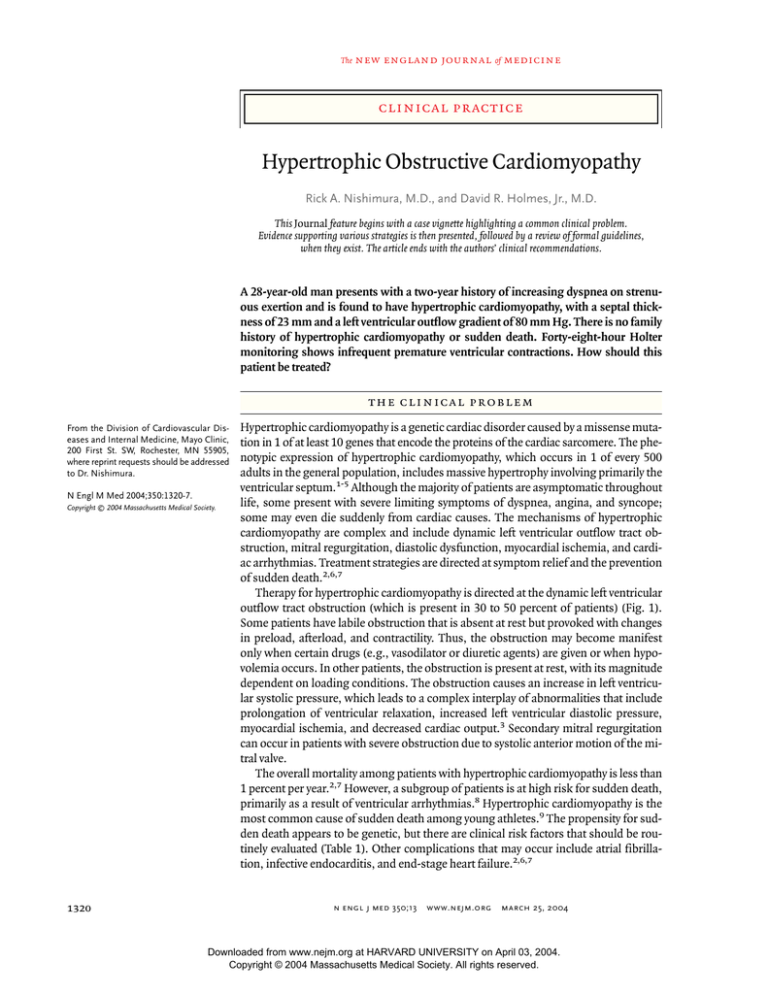
The
new england journal
of
medicine
clinical practice
Hypertrophic Obstructive Cardiomyopathy
Rick A. Nishimura, M.D., and David R. Holmes, Jr., M.D.
This Journal feature begins with a case vignette highlighting a common clinical problem.
Evidence supporting various strategies is then presented, followed by a review of formal guidelines,
when they exist. The article ends with the authors’ clinical recommendations.
A 28-year-old man presents with a two-year history of increasing dyspnea on strenuous exertion and is found to have hypertrophic cardiomyopathy, with a septal thickness of 23 mm and a left ventricular outflow gradient of 80 mm Hg. There is no family
history of hypertrophic cardiomyopathy or sudden death. Forty-eight-hour Holter
monitoring shows infrequent premature ventricular contractions. How should this
patient be treated?
the clinical problem
From the Division of Cardiovascular Diseases and Internal Medicine, Mayo Clinic,
200 First St. SW, Rochester, MN 55905,
where reprint requests should be addressed
to Dr. Nishimura.
N Engl M Med 2004;350:1320-7.
Copyright © 2004 Massachusetts Medical Society.
1320
Hypertrophic cardiomyopathy is a genetic cardiac disorder caused by a missense mutation in 1 of at least 10 genes that encode the proteins of the cardiac sarcomere. The phenotypic expression of hypertrophic cardiomyopathy, which occurs in 1 of every 500
adults in the general population, includes massive hypertrophy involving primarily the
ventricular septum.1-5 Although the majority of patients are asymptomatic throughout
life, some present with severe limiting symptoms of dyspnea, angina, and syncope;
some may even die suddenly from cardiac causes. The mechanisms of hypertrophic
cardiomyopathy are complex and include dynamic left ventricular outflow tract obstruction, mitral regurgitation, diastolic dysfunction, myocardial ischemia, and cardiac arrhythmias. Treatment strategies are directed at symptom relief and the prevention
of sudden death.2,6,7
Therapy for hypertrophic cardiomyopathy is directed at the dynamic left ventricular
outflow tract obstruction (which is present in 30 to 50 percent of patients) (Fig. 1).
Some patients have labile obstruction that is absent at rest but provoked with changes
in preload, afterload, and contractility. Thus, the obstruction may become manifest
only when certain drugs (e.g., vasodilator or diuretic agents) are given or when hypovolemia occurs. In other patients, the obstruction is present at rest, with its magnitude
dependent on loading conditions. The obstruction causes an increase in left ventricular systolic pressure, which leads to a complex interplay of abnormalities that include
prolongation of ventricular relaxation, increased left ventricular diastolic pressure,
myocardial ischemia, and decreased cardiac output.3 Secondary mitral regurgitation
can occur in patients with severe obstruction due to systolic anterior motion of the mitral valve.
The overall mortality among patients with hypertrophic cardiomyopathy is less than
1 percent per year.2,7 However, a subgroup of patients is at high risk for sudden death,
primarily as a result of ventricular arrhythmias.8 Hypertrophic cardiomyopathy is the
most common cause of sudden death among young athletes.9 The propensity for sudden death appears to be genetic, but there are clinical risk factors that should be routinely evaluated (Table 1). Other complications that may occur include atrial fibrillation, infective endocarditis, and end-stage heart failure.2,6,7
n engl j med 350;13
www.nejm.org
march 25, 2004
Downloaded from www.nejm.org at HARVARD UNIVERSITY on April 03, 2004.
Copyright © 2004 Massachusetts Medical Society. All rights reserved.
clinical practice
strategies and evidence
diagnostic evaluation
Hypertrophic cardiomyopathy may be suspected on
the basis of abnormalities found on cardiac examination or electrocardiography. Classic findings include a systolic ejection murmur that becomes increasingly loud during maneuvers that decrease
preload (such as a change in the patient’s position
from squatting to standing) and evidence of left
ventricular hypertrophy on electrocardiography.
The diagnosis can be confirmed by two-dimensional echocardiography, which shows hypertrophy of
the myocardium that is usually asymmetric, with the
septal thickness greater than the thickness of the
free wall (Fig. 2). Continuous-wave Doppler echocardiography is used to diagnose resting obstruction, which is evident as a high-velocity, late-peaking jet across the left ventricular outflow tract. In
patients with no obstruction or only slight obstruction (gradient, ≤30 mm Hg), provocative maneuvers
(such as the Valsalva maneuver or exercise) should
be performed to identify latent obstruction.
Once the diagnosis is made, the patient’s family
history (with special attention to hypertrophic cardiomyopathy or sudden death) should be carefully
obtained. All first-degree family members should
undergo periodic screening with echocardiography every five years for this autosomal dominant
disorder, since hypertrophy may not be appreciable
until the sixth to seventh decade of life. Annual
screening is recommended for adolescents 12 to
18 years of age. In the future, the diagnosis of hypertrophic cardiomyopathy may be based on the identification of mutations in the genes encoding the
sarcomeric proteins, but this technique is not currently the standard of care.4 Patients should undergo
an evaluation that includes 48-hour Holter monitoring and exercise testing, which provide prognostic information. All patients should be offered
instructions for prophylaxis against infective endocarditis and should be advised to avoid dehydration
and strenuous exertion (intense physical activity involving bursts of exertion or repeated isometric exercise).
pharmacologic therapy
The first-line approach to the relief of symptoms is
pharmacologic therapy designed to block the effects of catecholamines that exacerbate the outflow
tract obstruction and to slow the heart rate so that
diastolic filling is enhanced2,3,6,7 (Table 2). Al-
n engl j med 350;13
though no data from long-term randomized, controlled trials are available, beta-blockers are generally the initial choice for patients with symptomatic
hypertrophic obstructive cardiomyopathy and are
initially effective in 60 to 80 percent of patients.10,11
The calcium-channel blocker verapamil can also be
used and is associated with a similar rate of improvement in symptoms.12,13 It is used mainly in
patients who cannot tolerate beta-blockers. Death
has been reported in patients with severe symptoms, pulmonary hypertension, and severe outflow obstruction who are given verapamil.14 It is
therefore recommended either that verapamil not
A
200
180
PVC
160
140
120
100
Ao
80
60
LV
40
LA
20
B
200
180
160
140
Ao
120
100
80
LV
60
40
20
LA
Figure 1. Tracings Obtained during Cardiac Catheterization in a Patient
with Hypertrophic Cardiomyopathy and Obstruction, Showing the Dynamic
Nature of the Obstruction and Its Dependence on Loading Conditions and
Contractility of the Left Ventricle.
The tracings are from the left ventricle (LV), aorta (Ao), and left atrium (LA).
The tracings in Panel A show that there is no resting gradient in this patient.
However, the effect of premature ventricular contractions (PVC) is visible,
with a severe increase in gradient during the beat after the PVC. This marked
increase in obstruction is due to the increase in contractility and decrease in
afterload during the post-PVC beat. Panel B shows that during the strain
phase of a Valsalva maneuver (arrow), there is an increase in the outflow tract
gradient between the left ventricle and aorta as the preload is decreased. This
gradient decreases after the release of the Valsalva maneuver (arrowhead).
www.nejm.org
march 25, 2004
Downloaded from www.nejm.org at HARVARD UNIVERSITY on April 03, 2004.
Copyright © 2004 Massachusetts Medical Society. All rights reserved.
1321
The
new england journal
Table 1. Risk Factors for Sudden Death in Patients
with Hypertrophic Cardiomyopathy.*
Diastole
VS
Ao
1 cm
LV
LA
PW
* At some institutions, a high risk (warranting prophylactic
implantation of an automatic defibrillator) is defined as
the presence of one or more major risk factors or the
presence of three or more minor risk factors.
† This risk factor is defined as sudden death from hypertrophic cardiomyopathy in two or more first-degree relatives younger than 40 years of age. (Some institutions
define it as sudden death from hypertrophic cardiomyopathy in one or more first-degree relatives younger than 40
years of age.)
‡ This risk factor is defined as two or more episodes of syncope within one year.
§ This risk factor is defined as failure of the blood pressure
to rise by more than 25 mm Hg from base line or a decrease of more than 10 mm Hg from the maximal blood
pressure during exercise in an upright position.
¶ This risk factor is defined as the presence, on either
Holter monitoring or exercise testing, of one or more runs
of three or more consecutive ventricular extrasystoles with
a rate higher than 120 beats per minute and a duration of
less than 30 seconds.
¿ The presence of microvascular obstruction can be detected as perfusion defects on nuclear imaging or magnetic
resonance imaging.
be used in this subgroup of patients with severe
symptomatic obstruction or that its administration
be started in the hospital, because death usually occurs after the first several doses. For patients whose
symptoms are not controlled with a beta-blocker,
the addition of disopyramide should be considered,
since its negative inotropic effects further decrease
the outflow gradient and thereby improve symptoms.3,15 The choice of medication is based on efficacy and potential side effects.
other interventions
Surgical Septal Myectomy
Although medical therapy improves symptoms in
most patients, a subgroup will need further intervention. If the resting gradient is greater than 30
mm Hg (or the provocable gradient is greater than
50 mm Hg) and if the patient continues to have
symptoms of dyspnea or angina that limit daily ac-
n engl j med 350;13
medicine
A
Major risk factors
Cardiac arrest (ventricular fibrillation)
Spontaneous sustained ventricular tachycardia
Family history of sudden death†
Minor risk factors
Unexplained syncope‡
Left ventricular wall thickness >30 mm
Abnormal blood pressure on exercise§
Nonsustained ventricular tachycardia¶
Left ventricular outflow obstruction
Microvascular obstruction¿
High-risk genetic defect
1322
of
B
Systole
1 cm
VS
Ao
LV
LA
PW
Figure 2. Two-Dimensional Echocardiogram from a Patient with Severe Symptomatic Hypertrophic Obstructive Cardiomyopathy.
Panel A shows a still frame obtained during diastole.
There is a marked increase in the thickness of the ventricular septum (VS). Panel B shows a still frame obtained during systole. Systolic anterior motion of the
mitral-valve apparatus causes obstruction of the left ventricular (LV) outflow tract (arrow). Ao denotes aorta, LA
left atrium, and PW posterior wall.
tivity, other invasive interventions may be considered (Table 3). These interventions consist of surgical septal myectomy, dual-chamber pacing, and
catheter-based alcohol septal ablation. Although no
randomized trials that directly compare these interventions have been conducted, surgical septal
myectomy, which involves resection of the basal
septum, is considered the gold standard for the
treatment of symptomatic hypertrophic obstruc-
www.nejm.org
march 25 , 2004
Downloaded from www.nejm.org at HARVARD UNIVERSITY on April 03, 2004.
Copyright © 2004 Massachusetts Medical Society. All rights reserved.
clinical practice
tive cardiomyopathy16-18 (Fig. 3). More than 2000
patients have undergone septal myectomy since
the procedure was introduced in the 1960s. At experienced centers, the operative mortality in patients undergoing only this procedure is typically
less than 1 to 2 percent, although the risk may be
higher in older patients with coexisting conditions.
Heart block, aortic regurgitation, or septal defects
complicate the surgery in fewer than 3 percent.
Successful operation results in complete abolition of the gradient and mitral regurgitation, with
marked improvement in symptoms. Many patients
are able to achieve near-normal exercise capacity,
and nearly 90 percent are free of symptoms of dyspnea, angina, and exertional syncope postopera-
tively. Increases in peak oxygen consumption with
exercise and an improvement in the New York Heart
Association functional class after the operation
have been documented. Variations in the surgical
technique have been developed for patients with
concomitant midventricular obstruction or intrinsic abnormalities of the mitral-valve apparatus. Long-term follow-up (over periods of more
than 30 years) has shown that patients who have
undergone septal myectomy have long-lasting improvements in symptoms and exercise capacity and
no recurrence of outflow tract obstruction. The
major limitation of the procedure is that it requires
surgical expertise available only in a few tertiary referral centers.
Table 2. Medical Therapy in Patients with Hypertrophic Cardiomyopathy.*
Drug
Side Effects
Dose
Drug Actions*
Decrease
Resting
Gradient
Decrease
Exercise
Gradient
Improve
Diastolic
Function
Beta-blockers (e.g.,
atenolol, propranolol,
and metoprolol)
+
+++
+
25 mg twice daily
600 mg
daily
Resting heart
Bradycardia, hypotenrate <60–70
sion, fatigue, bronbeats/min
chospasm
Calcium blockers (e.g.,
verapamil)
+
+++
++
240 mg daily (longacting formulation)
480 mg
daily
Resting heart
Bradycardia, hypotenrate <60–70
sion, constipation
beats/min
Disopyramide†
++
+++
+
100 mg twice daily
(sustained release
formulation)
600 mg
daily
Relief of symptoms
Initial
Maximal
End Point
of Adjustment
Anticholinergic effect,
increase in the corrected QT interval
* A single plus sign denotes a mild effect, two plus signs a moderate effect, and three plus signs a large effect. A drug may improve diastolic function in part by decreasing obstruction.
† It is recommended that disopyramide be given with a beta-blocker to prevent a rapid ventricular response if atrial fibrillation occurs.
Table 3. Comparative Features of Septal-Reduction Therapies.
Therapy
Mortality
Residual
Gradient
Effectiveness
Follow-up
%
mm Hg
% of
Patients
Yr
Time to Resolution
of Gradient
Complications
Type
% of
Patients
<1
<40
10–40
10
Infection or perforation
<2
4 wk
Septal myectomy*
<2–3
<10
>90
>30
Complete heart block
Ventricular septal defect
Aortic regurgitation
<3
<1
<1
Immediate
Septal ablation†
<2–3
<20
70–80
<5
Complete heart block
Ventricular septal defect
Large myocardial infarction
10–40
Unknown
Unknown
8–12 wk
Dual-chamber pacing
* Surgical septal myectomy is the only intervention that can treat concomitant problems, such as multivessel coronary disease, intrinsic mitralvalve disease, midventricular obstruction, and fixed subaortic obstruction.
† The true rates of death and complications may be underestimated, since complications may occur at a higher frequency in the inexperienced
centers and may be underreported.
n engl j med 350;13
www.nejm.org
march 25, 2004
Downloaded from www.nejm.org at HARVARD UNIVERSITY on April 03, 2004.
Copyright © 2004 Massachusetts Medical Society. All rights reserved.
1323
The
new england journal
Implantation of a Dual-Chamber Pacemaker
Implantation of a dual-chamber pacemaker has
been proposed as a therapeutic alternative that is
less invasive than surgical myectomy. The mechanism of the therapeutic effect derived from pacing
is unclear, but it is proposed that the initiation of
the electrical impulse in the apex of the right ventricle alters the systolic contraction sequence of the
basal septum, leading to a reduction in the outflow
gradient. Although relief of symptoms and reduction of the gradient have been found in observa-
of
medicine
tional trials,19 the initial enthusiasm for the use of
pacemakers in this setting has been dampened by
results of randomized clinical trials showing a
large placebo effect and no significant improvement in objective measures of exercise capacity.20,21
The average residual gradient after pacing is still 30
to 50 mm Hg. At five years of follow-up, fewer than
40 percent of patients continue to have improvements in symptoms (although older patients may
be more likely to have a sustained benefit), and the
degree of improvement is less than that achieved
A
B
Reduced
outflow
Mitral
regurgitation
Septal
myectomy
C
Increased
outflow
Incision line
through hypertrophied
basal septum
Figure 3. Schematic Diagram of a Patient Undergoing Surgical Septal Myectomy.
Before the operation, there is severe hypertrophy of the basal septum, with systolic anterior motion of the mitral valve
(Panel A). This results in severe outflow tract obstruction as well as mitral regurgitation. During surgery (Panel B), the
portion of the basal septum that projects into the outflow tract is removed by a scalpel, resulting in abolition of the outflow tract obstruction (Panel C). In addition, there is no longer systolic anterior motion of the mitral valve, and the mitral
regurgitation is abolished.
1324
n engl j med 350;13
www.nejm.org
march 25 , 2004
Downloaded from www.nejm.org at HARVARD UNIVERSITY on April 03, 2004.
Copyright © 2004 Massachusetts Medical Society. All rights reserved.
clinical practice
with the other therapies.22,23 Thus, dual-chamber
pacing is limited to patients who have coexisting
illnesses that are contraindications to other therapies or those who require pacing for bradycardia.
Alcohol-Induced Septal Ablation
Alcohol-induced septal ablation is a newer method
of treating hypertrophic cardiomyopathy. This procedure is performed in the catheterization laboratory, where 100 percent alcohol is infused selectively
into a septal perforator artery (or branch) that perfuses the proximal septum,24,25 producing a controlled myocardial infarction. The subsequent thinning and remodeling of the basal septal region
decrease obstruction over a period of months. The
initial results from several centers have shown improvements in hemodynamic variables and symptoms, with a decrease in the outflow gradient from
60 to 70 mm Hg to less than 20 mm Hg. Improved
exercise performance has been documented, but
not to the extent that has been shown after surgery.
Initially, complete heart block requiring permanent
pacing occurred in 30 to 40 percent of cases, but in
experienced centers where smaller doses of alcohol
were used in combination with myocardial contrast
echocardiography (to localize the area of myocardium perfused by a septal artery), heart block occurred
in fewer than 15 to 20 percent. Other complications,
such as a large myocardial infarction, ventricular
septal defect, intractable ventricular fibrillation, and
myocardial perforation, have been described, although their incidence is uncertain, in part because
these events are probably underreported.
Although no randomized trials comparing septal ablation with septal myectomy have been conducted, the rate of complete abolition of obstruction
and relief of symptoms appears to be lower with septal ablation than with septal myectomy. This difference may be explained by the highly variable anatomical course of the septal perforator arteries26;
up to 20 percent of patients may not have a perforator artery that supplies the critical area of septal hypertrophy. Moreover, benefit may not be obtained
because coexisting conditions, such as intrinsic mitral-valve disease, midventricular obstruction, or
fixed subaortic obstruction, may be present; these
conditions are amenable only to operative intervention.27
matic defibrillator should be considered) is an important part of the evaluation.8,9 An increased risk
of sudden death runs in families, and “malignant”
genetic mutations have been identified. Currently,
however, the clinical value of genetic screening is
unknown, and clinical risk factors should be used
for assessment. A history of out-of-hospital cardiac arrest and documented, sustained ventricular
tachycardia or fibrillation are powerful predictors of
future events, and a family history that includes sudden death among first-degree relatives with hypertrophic cardiomyopathy is a strong predictor of sudden death. The presence of other risk factors (Table
1) may as much as double the risk of sudden death,
but a single risk factor has low predictive value
(less than 20 percent), in part because event rates
are low.2,7,8,28 Electrophysiological studies are not
considered useful for identifying patients at risk for
sudden death, since ventricular arrhythmias are
commonly provoked at the time of an electrophysiological study and are of low predictive value.
The implantation of an automatic defibrillator
is the treatment of choice to prevent sudden death.29
In any individual patient, an overall assessment of
major and minor risk factors and coexisting conditions should be used to determine whether use of
an automatic defibrillator is indicated. The high
negative predictive value of these clinical markers
(greater than 90 percent) suggests that the absence
of risk factors can be used to identify patients in
whom the likelihood of sudden death is low.
other complications
In patients with hypertrophic cardiomyopathy, severe hemodynamic compromise may develop when
there are acute changes in loading conditions. For
example, in an intensive care setting, a patient’s condition may become unstable when there is volume
depletion and treatment with inotropic agents is
being given. The infusion of fluids and discontinuation of inotropic agents is the initial therapy. A betablocker should be added, but if hypotension is
present, a vasoconstrictor such as phenylephrine
should be administered first.
An acute onset of atrial fibrillation, resulting in
severe hemodynamic compromise owing to tachycardia and loss of atrial contraction, can be lifethreatening. As described above, the treatment of
the hemodynamic compromise should include the
risk of sudden death
administration of a pressor agent, fluids, and betaThe identification of patients at increased risk for blockers and prompt cardioversion. Some patients
sudden death (in whom implantation of an auto- have paroxysmal or chronic atrial fibrillation, which
n engl j med 350;13
www.nejm.org
march 25, 2004
Downloaded from www.nejm.org at HARVARD UNIVERSITY on April 03, 2004.
Copyright © 2004 Massachusetts Medical Society. All rights reserved.
1325
The
new england journal
exacerbates the symptoms of their hypertrophic
cardiomyopathy.30 Anticoagulation should be considered for these patients (unless they have an absolute contraindication to it) because of the risk of
embolism. According to clinical experience, the
treatment of choice for recurrent atrial fibrillation
is low-dose amiodarone, since other antiarrhythmic agents are generally not effective.
guidelines
of
medicine
there is no response to medications. The choice of
procedure should be based on the preferences of
the patient and the physician, and the patient should
be fully informed about the potential risks and benefits of each approach. Septal myectomy is not widely available, and older, sicker patients may be at
increased risk for complications. Thus, selected
patients may be treated with septal ablation if the
following criteria are met: there is a suitable coronary arterial supply; there are no other problems
requiring additional surgery, such as midventricular obstruction or intrinsic mitral-valve disease; and
the procedure is performed at a center where the
staff has extensive experience in the technique, as
well as thorough knowledge of the disease process.
Guidelines for the management of hypertrophic
cardiomyopathy have been issued by the American
College of Cardiology and the European Society of
Cardiology.31,32 In the absence of large randomized
trials of management strategies, the guidelines are
based largely on small observational studies and
conclusions
consensus opinion. The key recommendations reand recommendations
garding therapy are consistent with those deThe management of hypertrophic cardiomyopathy
scribed in this article.
includes reduction of the outflow tract obstruction
to relieve symptoms and assessment of the risk of
areas of uncertainty
sudden death. Initial referral to a cardiologist with
The optimal treatment for patients who have severe- expertise in the disease and periodic follow-up by a
ly symptomatic hypertrophic obstructive cardiomy- cardiologist should be strongly considered. For paopathy that is refractory to drug treatment is un- tients with symptomatic hypertrophic cardiomyopknown. No randomized trials comparing therapies athy and obstruction, medical therapy is the initial
in such patients have been conducted, and data are treatment of choice. For patients who have continlimited to observational studies. Although septal ued symptoms that limit their lifestyle despite optiablation is an attractive alternative to open heart sur- mal medical therapy, other therapies, such as septal
gery, surgical septal myectomy should be consid- ablation and septal myectomy, can be considered,
ered the treatment of choice for these patients, in but these procedures should be performed at expeview of its established results over long-term fol- rienced centers.
All patients with hypertrophic cardiomyopathy
low-up periods. There has been concern that the
myocardial infarction resulting from alcohol septal should undergo an evaluation in which their risk of
ablation may have detrimental long-term effects; sudden death is assessed. Implantation of an autothe length of follow-up after ablation has been less matic defibrillator may be considered for patients
than five years.33 An increased tendency to arrhyth- believed to be at high risk on the basis of noninvamia or abnormal remodeling (such as left ventricu- sive clinical markers. Follow-up is guided by symplar dilatation due to expansion of an infarct) are toms and includes continued assessment of the
potential adverse consequences of an induced my- risk of sudden death; Holter monitoring and exerocardial infarction, especially in patients with un- cise testing are performed on an annual basis. Seriderlying myocardial disease. Although septal abla- al imaging studies may not be necessary in patients
tion may be perceived as relatively easy to perform, whose condition is stable.
The patient described in the vignette should not
it is not free of complications and requires techniundergo an invasive therapeutic procedure unless
cal expertise.
There are no data to indicate that any procedure he continues to have severe symptoms after receivto reduce septal thickness can prevent sudden ing medical therapy. Although data comparing difdeath, especially in patients with mild symptoms ferent medications are lacking, we would start with
or none; thus such interventions should be per- a beta-blocker and consider adding disopyramide
formed only in patients who have outflow tract ob- if his symptoms persisted despite the use of maxistruction and limiting symptoms and in whom mal doses. The majority of patients have a good re-
1326
n engl j med 350;13
www.nejm.org
march 25 , 2004
Downloaded from www.nejm.org at HARVARD UNIVERSITY on April 03, 2004.
Copyright © 2004 Massachusetts Medical Society. All rights reserved.
clinical practice
sponse to medical therapy, with improvement in would consider his prognosis excellent with the
their symptoms. There are no indications that this use of medical therapy alone.
patient has a high risk of sudden death, and we
references
1. Braunwald E, Lambrew CT, Rockoff SD,
14. Epstein SE, Rosing DR. Verapamil: its
Ross J Jr, Morrow AG. Idiopathic hypertrophic subaortic stenosis. I. A description
of the disease based upon an analysis of 64
patients. Circulation 1964;30:Suppl IV:IV3–IV-119.
2. Maron BJ. Hypertrophic cardiomyopathy: a systematic review. JAMA 2002;287:
1308-20.
3. Wigle ED, Sasson Z, Henderson MA, et
al. Hypertrophic cardiomyopathy: the importance of the site and the extent of hypertrophy: a review. Prog Cardiovasc Dis 1985;28:
1-83.
4. Marian AJ, Roberts R. Recent advances
in the molecular genetics of hypertrophic
cardiomyopathy. Circulation 1995;92:133647.
5. Braunwald E, Seidman CE, Sigwart U.
Contemporary evaluation and management
of hypertrophic cardiomyopathy. Circulation 2002;106:1312-6.
6. Maron BJ, Bonow RO, Cannon RO III,
Leon MB, Epstein SE. Hypertrophic cardiomyopathy: interrelations of clinical manifestations, pathophysiology, and therapy.
N Engl J Med 1987;316:844-52.
7. Spirito P, Seidman CE, McKenna WJ,
Maron BJ. The management of hypertrophic
cardiomyopathy. N Engl J Med 1997;336:
775-85.
8. Maron BJ, Estes NA III, Maron MS, Almquist AK, Link MS, Udelson JE. Primary prevention of sudden death as a novel treatment
strategy in hypertrophic cardiomyopathy.
Circulation 2003;107:2872-5.
9. Maron BJ. Sudden death in young athletes. N Engl J Med 2003;349:1064-75.
10. Flamm MD, Harrison DC, Hancock EW.
Muscular subaortic stenosis: prevention of
outflow obstruction with propranolol. Circulation 1968;38:846-58.
11. Cohen LS, Braunwald E. Amelioration
of angina pectoris in idiopathic hypertrophic
subaortic stenosis with beta-adrenergic
blockade. Circulation 1967;35:847-51.
12. Bonow RO, Dilsizian V, Rosing DR,
Maron BJ, Bacharach SL, Green MV. Verapamil-induced improvement in left ventricular
diastolic filling and increased exercise tolerance in patients with hypertrophic cardiomyopathy: short- and long-term effects. Circulation 1985;72:853-64.
13. Rosing DR, Condit JR, Maron BJ, et al.
Verapamil therapy: a new approach to the
pharmacologic treatment of hypertrophic
cardiomyopathy. III. Effects of long-term
administration. Am J Cardiol 1981;48:54553.
potential for causing serious complications
in patients with hypertrophic cardiomyopathy. Circulation 1981;64:437-41.
15. Pollick C. Muscular subaortic stenosis:
hemodynamic and clinical improvement
after disopyramide. N Engl J Med 1982;307:
997-9.
16. Morrow AG. Hypertrophic subaortic
stenosis: operative methods utilized to
relieve left ventricular outflow obstruction.
J Thorac Cardiovasc Surg 1978;76:423-30.
17. McCully RB, Nishimura RA, Tajik AJ,
Schaff HV, Danielson GK. Extent of clinical
improvement after surgical treatment of
hypertrophic obstructive cardiomyopathy.
Circulation 1996;94:467-71.
18. Schulte HD, Borisov K, Gams E, GramschZabel H, Losse B, Schwartzkopff B. Management of symptomatic hypertrophic obstructive cardiomyopathy — long-term results
after surgical therapy. Thorac Cardiovasc
Surg 1999;47:213-8.
19. Fananapazir L, Epstein ND, Curiel RV,
Panza JA, Tripodi D, McAreavey D. Longterm results of dual-chamber (DDD) pacing
in obstructive hypertrophic cardiomyopathy: evidence for progressive symptomatic
and hemodynamic improvement and reduction of left ventricular hypertrophy. Circulation 1994;90:2731-42.
20. Nishimura RA, Trusty JM, Hayes DL, et
al. Dual-chamber pacing for hypertrophic
cardiomyopathy: a randomized, doubleblind, crossover study. J Am Coll Cardiol
1997;29:435-41.
21. Maron BJ, Nishimura RA, McKenna WJ,
Rakowski H, Josephson ME, Kieval RS.
Assessment of permanent dual-chamber
pacing as a treatment for drug-refractory
symptomatic patients with obstructive
hypertrophic cardiomyopathy: a randomized, double-blind, crossover study (MPATHY). Circulation 1999;99:2927-33.
22. Nishimura RA, Symanski JD, Hurrell
DG, Trusty JM, Hayes DL, Tajik AJ. Dualchamber pacing for cardiomyopathies: a
1996 clinical perspective. Mayo Clin Proc
1996;71:1077-87.
23. Ommen SR, Nishimura RA, Squires
RW, Schaff HV, Danielson GK, Tajik AJ.
Comparison of dual-chamber pacing versus
septal myectomy for the treatment of
patients with hypertrophic obstructive cardiomyopathy: a comparison of objective
hemodynamic and exercise end points. J Am
Coll Cardiol 1999;34:191-6.
24. Seggewiss H, Gleichmann U, Faber L,
Fassbender D, Schmidt HK, Strick S. Percu-
n engl j med 350;13
www.nejm.org
taneous transluminal septal myocardial
ablation in hypertrophic obstructive cardiomyopathy: acute results and 3-month follow-up in 25 patients. J Am Coll Cardiol
1998;31:252-8.
25. Sigwart U. Non-surgical myocardial
reduction for hypertrophic obstructive cardiomyopathy. Lancet 1995;346:211-4.
26. Singh M, Edwards WD, Holmes DR Jr,
Tajik AJ, Nishimura RA. Anatomy of the first
septal perforating artery: a study with implications for ablation therapy for hypertrophic cardiomyopathy. Mayo Clin Proc
2001;76:799-802.
27. Maron BJ, Nishimura RA, Danielson
GK. Pitfalls in clinical recognition and a
novel operative approach for hypertrophic
cardiomyopathy with severe outflow obstruction due to anomalous papillary muscle. Circulation 1998;98:2505-8.
28. Elliott PM, Gimeno Blanes JR, Mahon
NG, Poloniecki JD, McKenna WJ. Relation
between severity of left-ventricular hypertrophy and prognosis in patients with hypertrophic cardiomyopathy. Lancet 2001;357:
420-4.
29. Maron BJ, Shen W-K, Link MS, et al.
Efficacy of implantable cardioverter–defibrillators for the prevention of sudden death
in patients with hypertrophic cardiomyopathy. N Engl J Med 2000;342:365-73.
30. Olivotto I, Cecchi F, Casey SA, Dolara A,
Traverse JH, Maron BJ. Impact of atrial
fibrillation on the clinical course of hypertrophic cardiomyopathy. Circulation 2001;
104:2517-24.
31. Maron BJ, McKenna WJ, Danielson GK,
et al. ACC/ESC clinical expert consensus
document on hypertrophic cardiomyopathy: a report of the American College of Cardiology Task Force on Clinical Expert Consensus Documents and the European Society
of Cardiology Committee for Practice Guidelines. Eur Heart J 2003;24:1965-91.
32. Maron BJ, McKenna WJ, Danielson GK,
et al. ACC/ESC expert consensus document:
a report of the American College of Cardiology Foundation Task Force on Clinical Expert
Consensus Documents and the European
Society of Cardiology Committee for Practice
Guidelines. J Am Coll Cardiol 2003;42:1687713. (Also available at http://www. acc.org/
clinical/consensus/cardiomyopathy/index.
pdf.)
33. Maron BJ. Role of alcohol septal ablation in treatment of obstructive hypertrophic cardiomyopathy. Lancet 2000;355:
425-6.
Copyright © 2004 Massachusetts Medical Society.
march 25, 2004
Downloaded from www.nejm.org at HARVARD UNIVERSITY on April 03, 2004.
Copyright © 2004 Massachusetts Medical Society. All rights reserved.
1327

